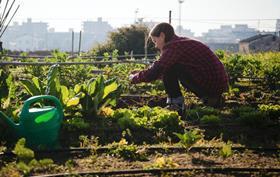
The first nationwide study of urban growing potential has illustrated the potential for an urban agricultural revolution in the UK, according to Jess Davies, professor of sustainability at Lancaster University and principal investigator of the study.
The UK's 'high reliance on imported fruit and vegetables', combined with unprecedented political upheaval and global health challenges that can disrupt food supplies and flows of horticulture workers, 'place the national food system at risk in terms of food access and availability', the report stated.
Between 1996 and 2015, the UK's imports of fresh fruit and vegetables, almost doubled. And projected rates of urban population growth in the UK are high, with 90 per cent of the population forecast to live in urban areas in 2050, compared with the European average of 83 per cent.
'This exposes the UK food system to risk of labour shortages in rural locations where agriculture is traditionally located,' the report stated, 'as well as transport and supply chain disruptions, which would have the negative effect of increasing the price of food or leading to shortages of fresh fruit and vegetables.'
Urban potential
Several recent studies have pointed to the productive potential of urban areas. 'In a global scale analysis,' the report pointed out, 'estimates suggest that 25–50 per cent of the UK’s urban space could be cultivated to meet the daily recommended intake of fresh fruit and vegetables for urban dwellers.'
Another study showed that 5-10 per cent of the global production of pulses, roots, tubers and vegetables could be supported by urban growing.
A more geographically focused analysis of allotment areas in the city of Sheffield found that there was more than enough land to support all the fresh fruit and vegetable needs of its inhabitants.
The Lancaster University study focused on the horticultural potential of outdoor green spaces, due to the lower setup costs compared with indoor farming, and on products relatively suited to UK growing conditions and consumer preferences, namely topfruit, soft fruit, roots and onions, brassicas, legumes and others (including peppers and salads).
'At its upper limit, we estimated that urban green space could support production of 20.70–22.41 tonnes of fresh fruit and vegetables per year in Great Britain, if all urban green spaces were utilised and expected average crop yields were achieved,' it stated. 'This compared with total average annual domestic production of 2.89 tonnes and imports of 56.40 tonnes.
'Comparing only the categories of fresh fruit and vegetables that are suitable for production in Great Britain (i.e. excluding exotic fruit and vegetable categories), then our estimates indicated that urban green space could produce 3.8-4.1 times the total fresh fruit and vegetables produced domestically.'
Meanwhile, the role of urban agriculture in meeting the sustainable development goals is increasingly gaining acceptance, according to the report.
“The intergovernmental panel on climate change highlights the role of urban agriculture (UA) in climate mitigation, the Food and Agriculture Organisation encourages integrating urban food into urban planning, and there is increasing recognition that small-scale food production in urban areas contributes to the sustainable development goals,' it stated.



